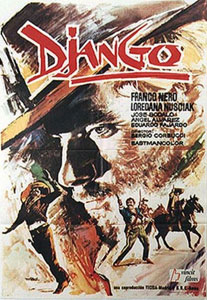 Italian hunk Franco Nero is the titular hero Django (1966). He appears afoot, arriving in town, dragging a coffin behind him.
Italian hunk Franco Nero is the titular hero Django (1966). He appears afoot, arriving in town, dragging a coffin behind him.
Saving a woman from torture along the way, he arrives in a filthy grubby town & takes up residence in a whorehouse/saloon, revealing only that he "has business" with the place. The hookers are mostly ugly & disgusting.
Apart for the well-cared-for Sergio Leone classics, most spaghetti westerns are available only as the same bad dubs that were prepared for North American release decades ago, the modern dvds frequently nothing but cropped transfers from those initial prints, faded, worn, with missing bits. And for the ones you can get as European copies in the original Italian, they generally won't have subtitles.
But Djangois available as a deluxe dvd with its original Italian soundtrack with subtitles, & with a dubbed soundtrack. The dubbing is so bad that it's actually better to view it in the Italian, weird though it is to see the wild west populated only by Italian speakers. The music is far better on the Italian soundtrack as well, & is practically a character in itself.
The town, or what's left of it, is ruled by evil Confederate Major Jackson (Eduardo Fajardo), who shoots Mexicans like doing so\ was a carnival game. Maria (Loredana Nusciak), the woman Django saved, is someone the Major wants dead. His henchman Ringo (Jose Terron) has a large facial scar.
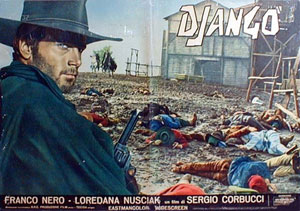 The Major comes to kill Django, but manages only to get all the men he brings with him killed. Our thrilling anti-hero Django asks, "How many men you got left, Major?" The Major says he has forty-eight. Django tells him to go gather 'em up. The Major comes to kill Django, but manages only to get all the men he brings with him killed. Our thrilling anti-hero Django asks, "How many men you got left, Major?" The Major says he has forty-eight. Django tells him to go gather 'em up.
These men wear red hoods & a burning cross is their emblem, imitative of history's actual White Caps who really did exist to kill Mexicans & were precursors to the Ku Klux Klan. So even though it's kind of dorky in this spaghetti western, a gang of hooded racists is not as far off the wall as it looks.
The coffin Django dragged into town has a gatling gun in it, sufficient to take down forty-eight men in the street. Major Jackson, however, is allowed to live.
Mexican outlaw rebels arrive next, & they are just as evil as the Major's gang had been. They cut off one guy's ear & make him eat it before killing him. They, too, are after Maria.
The story takes an unexpected turn when it appears that Django is friends with the Mexican General Hugo Rodriguez (Jose Bodalo), to whom he wants to sell ten gatling guns, & with whom he has a plan to rob Fort Chariba which is "brimming with gold."
It turns into a tale of killing a lot of people for gold & it frankly gets terribly boring after a while. Everyone betrays someone, & not even Django has a moral thread anywhere on his person. The gatling gun continues to be a central piece of the action, & its merely redundant.
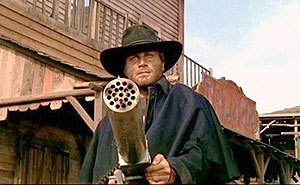 General Rodriguez isn't Django's friend after all. He captures Django, shoots Maria (she survives), & mashes Django's hands to a pulp. General Rodriguez isn't Django's friend after all. He captures Django, shoots Maria (she survives), & mashes Django's hands to a pulp.
By the hand-mashing scene, it's pretty obvious Corbucci is intentionally parodying Kurosawa's Yojimbo (1961), a profound influence on director Sergio Corbucci, although the story varies a bit so as not to be identical Sergio Leone's much better Yojimbo rip-off, A Fistful of Dollars (1964).
General Rodriguez & Major Jackson make what appears to be an alliance, but no sooner has the Major joined with Rodriguez than he oversees the eradication of the Mexicans, in what begins to feel like an increasingly pointless festival of noisy smoky slaughter. Meanwhile Django with broken fingers waits for the Major in the cemetery. He's quite pathetic trying with only his teeth & two mashed hands to manage a gun, but he wins anyway, cuz he's Django.
Add to all this nonsense a tacky-cool theme song performed by Rocky Roberts, & general soundtrack by Luis Bacalov only slightly less incredible than Ennio Morricone's work for Leone, & you've got yourself a perfectly ridiculous western that's loads of fun, just so long as you have nothing more than a b-movie or grindhouse expectation.
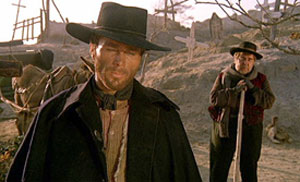 Many regard Django as the ideal spaghetti western for exemplifying everything that's good, & everything that's awful, about the genre. Many regard Django as the ideal spaghetti western for exemplifying everything that's good, & everything that's awful, about the genre.
Sergio Leone's westerns really transcend the spaghetti western mode, even while informing it profoundly, & it takes "lesser" directors like Corbucci to completely convey what the 1960s fad for Eurowesterns was really like.
And the novel ingredient for Corbucci's vision of the American west is borrowed from his own euro-horror films, in which the very landscape becomes a symbol of death, together with that winning image of dragging a coffin across the desert. The clouded shadowy sky would've been just as appropriate to horror.
The intensity of the violence got Django banned in England, & it was not legally shown there for twenty-five years. That didn't keep it from being a world-wide hit, & Django birthed dozens of unofficial sequels.
It's influence continues to this day, the severed ear scene imitated in Quentin Tarantino's Reservoir Dogs (1992), & Django greatly parodied, & yet improved upon, in Takashi Miike's Sukiyaki Western Django (2007).
The iconic coffin-dragging scene alone has been imitated in episodes of two science fiction anime series, Tenchi Universe (Tenchi muyo, 1999) & Cowboy Bebop (Kauboi beboppu, 1998); in the wild west video game Red Dead Revolver (2004) & s-f video game Boktai (Bokura no Taiyo, 2003).
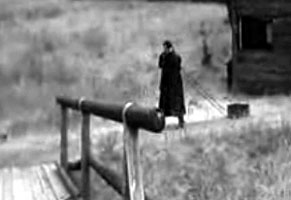 The coffin-dragging reference even made its way into a couple of music videos, includingCrawl Across Your Killing Floor (2007) by horror-rocker Glenn Danzig. The coffin-dragging reference even made its way into a couple of music videos, includingCrawl Across Your Killing Floor (2007) by horror-rocker Glenn Danzig.
The black & white photography of the five & a half minute video captures the look of a vintage B-western, & Danzig looks good in a leather duster on the street of a tumbleweed-haunted ghost town, a child's coffin in tow as he strides along the countryside.
He enters a saloon & encounters a goth gal who plays off the character of Maria also from Django. The song itself mixes heavy metal guitar riffs with doomful western ballad, with lyrics like "Seen a lot of hatred, since the dawn of time/ Seen the Devil walkin', done a lot of crime."
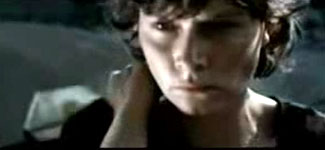 The dragged coffin motif also pops up in Vacuity (2008) by French death-metal band Gojira. The dragged coffin motif also pops up in Vacuity (2008) by French death-metal band Gojira.
Within a collage of images & rock performance, a central recurring "story thread" becomes evident, showing a young woman (Claire Theodoly) dragging a coffin down the middle of a rural route highway. The under-five-minute video promoted Gojira's 2008 album The Way of All Flesh.
The music is Joseph Duplantier's growly death-metal of the most cliche sort, but the photography is great, with a most striking image of the coffin plummeting from a clif, & all building toward a revelation of the woman buried alive.
Other pop-culture references to Django could be named. Some American film fans may be surprised about this lingering impact, as the film was never as well known in in the USA as it had been in so many countries.
The dvd release that fell into my hands included an interesting thirteen-minute documentary Django: The One & Only (2002). It's made up of interviews with star Franco Nero & with Corbucci's assistant director.
copyright © by Paghat the Ratgirl
|
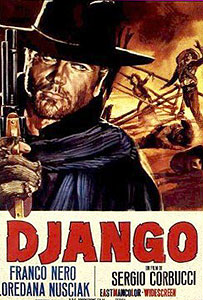

 The Major comes to kill Django, but manages only to get all the men he brings with him killed. Our thrilling anti-hero Django asks, "How many men you got left, Major?" The Major says he has forty-eight. Django tells him to go gather 'em up.
The Major comes to kill Django, but manages only to get all the men he brings with him killed. Our thrilling anti-hero Django asks, "How many men you got left, Major?" The Major says he has forty-eight. Django tells him to go gather 'em up. General Rodriguez isn't Django's friend after all. He captures Django, shoots Maria (she survives), & mashes Django's hands to a pulp.
General Rodriguez isn't Django's friend after all. He captures Django, shoots Maria (she survives), & mashes Django's hands to a pulp. Many regard Django as the ideal spaghetti western for exemplifying everything that's good, & everything that's awful, about the genre.
Many regard Django as the ideal spaghetti western for exemplifying everything that's good, & everything that's awful, about the genre. The coffin-dragging reference even made its way into a couple of music videos, includingCrawl Across Your Killing Floor (2007) by horror-rocker Glenn Danzig.
The coffin-dragging reference even made its way into a couple of music videos, includingCrawl Across Your Killing Floor (2007) by horror-rocker Glenn Danzig. The dragged coffin motif also pops up in Vacuity (2008) by French death-metal band Gojira.
The dragged coffin motif also pops up in Vacuity (2008) by French death-metal band Gojira.